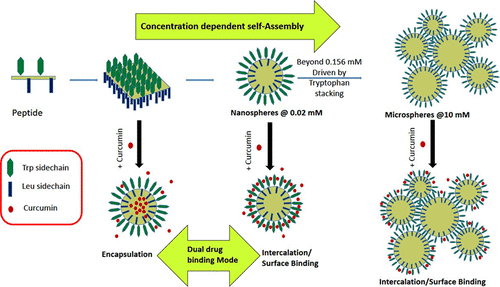Our official English website, www.x-mol.net, welcomes your
feedback! (Note: you will need to create a separate account there.)
Self-Assembly Mechanism of a Peptide-Based Drug Delivery Vehicle
ACS Omega ( IF 3.7 ) Pub Date : 2018-03-15 00:00:00 , DOI: 10.1021/acsomega.7b01871 Gopal Pandit 1 , Karabi Roy 1 , Umang Agarwal 1 , Sunanda Chatterjee 1
ACS Omega ( IF 3.7 ) Pub Date : 2018-03-15 00:00:00 , DOI: 10.1021/acsomega.7b01871 Gopal Pandit 1 , Karabi Roy 1 , Umang Agarwal 1 , Sunanda Chatterjee 1
Affiliation

|
We report the mechanism of the concentration-dependent self-assembly of a tetrapeptide. Peptide Boc-Trp-Leu-Trp-Leu-OMe self-assembles to form discrete nanospheres at a low concentration. Tryptophan side chains point outwards of the nanospheres while leucine side chains point towards the core of the nanospheres. The nanospheres fuse together to become microspheres with the increase in the peptide concentration. At higher concentrations of the peptide, the microspheres start clustering. This is stabilized by the aromatic interactions between the side chains of the tryptophan residues that cover the outer surface of the peptide microspheres. In addition to behaving like the conventional hollow sphere-based drug delivery vehicles which entraps the drug and performs stimuli-responsive release, this prototype can interact, stabilize, and intercalate hydrophobic dye carboxyfluorescein and anti-cancer drug curcumin even on the surface through aromatic interactions. The dye/drug can be released in acidic pH and in the presence of physiologically relevant ions such as potassium.
中文翻译:

肽类药物输送载体的自组装机制
我们报告了四肽浓度依赖性自组装的机制。肽 Boc-Trp-Leu-Trp-Leu-OMe 在低浓度下自组装形成离散的纳米球。色氨酸侧链指向纳米球的外侧,而亮氨酸侧链指向纳米球的核心。随着肽浓度的增加,纳米球融合在一起成为微球。在肽浓度较高时,微球开始聚集。这是通过覆盖肽微球外表面的色氨酸残基侧链之间的芳香族相互作用来稳定的。除了像传统的基于空心球的药物递送载体一样,捕获药物并执行刺激响应释放外,该原型甚至可以通过芳香族相互作用在表面上相互作用、稳定和插入疏水性染料羧基荧光素和抗癌药物姜黄素。染料/药物可以在酸性 pH 值和生理相关离子(例如钾)存在下释放。
更新日期:2018-03-15
中文翻译:

肽类药物输送载体的自组装机制
我们报告了四肽浓度依赖性自组装的机制。肽 Boc-Trp-Leu-Trp-Leu-OMe 在低浓度下自组装形成离散的纳米球。色氨酸侧链指向纳米球的外侧,而亮氨酸侧链指向纳米球的核心。随着肽浓度的增加,纳米球融合在一起成为微球。在肽浓度较高时,微球开始聚集。这是通过覆盖肽微球外表面的色氨酸残基侧链之间的芳香族相互作用来稳定的。除了像传统的基于空心球的药物递送载体一样,捕获药物并执行刺激响应释放外,该原型甚至可以通过芳香族相互作用在表面上相互作用、稳定和插入疏水性染料羧基荧光素和抗癌药物姜黄素。染料/药物可以在酸性 pH 值和生理相关离子(例如钾)存在下释放。











































 京公网安备 11010802027423号
京公网安备 11010802027423号